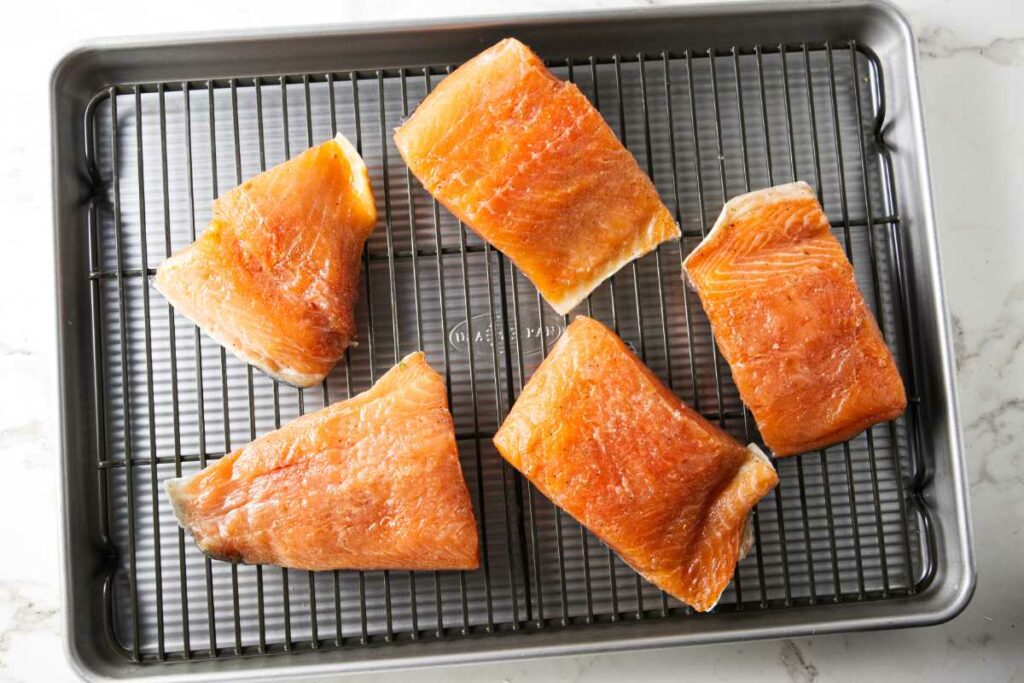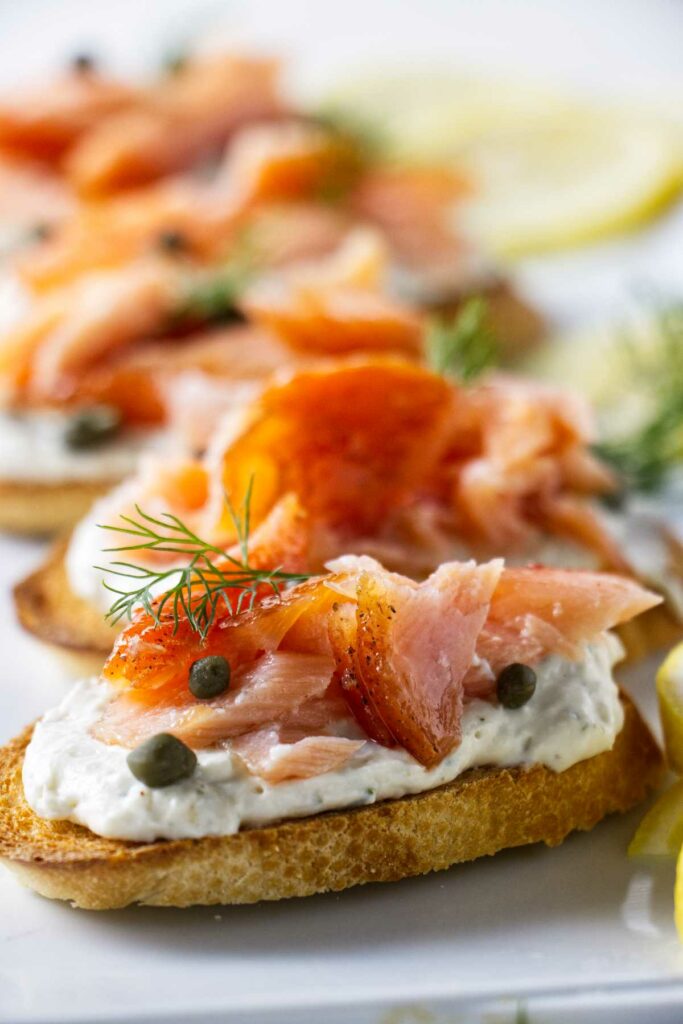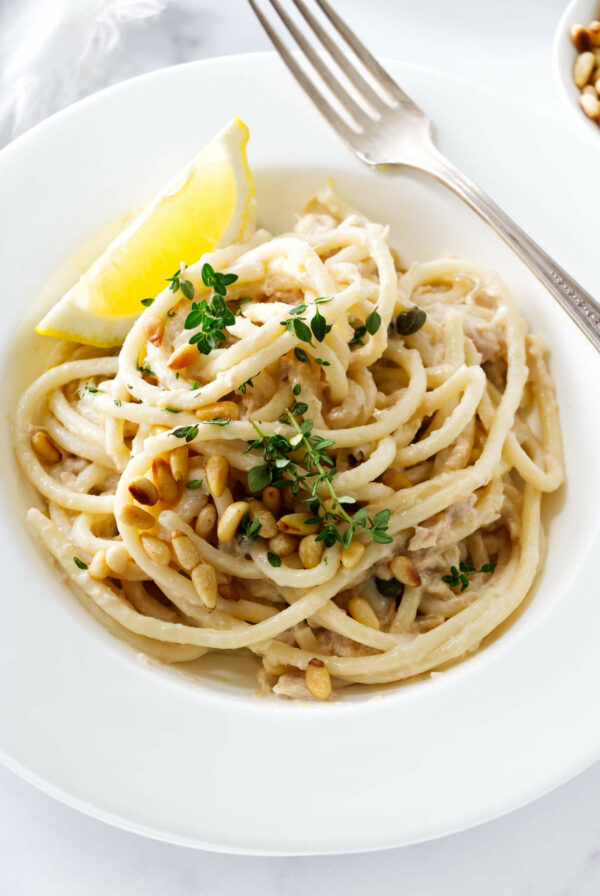This post may contain affiliate links. Please read our disclosure policy. As an Amazon Associate, I earn from qualifying purchases.
Smoky and briny, and incredibly tender, this Traeger smoked salmon recipe makes a beautifully smoked salmon with great flavor that is perfect for any occasion! After smoking fish on your Traeger (or similar pellet grill), you’ll never want to go back to store-bought again. The smoking process is simple, and an easy dry brine ensures that the fish is perfectly seasoned and cured.

Why this Recipe Works
Our Traeger smoked salmon recipe will give you the best salmon with an unbeatable smoky flavor. It’s so easy to make on a Traeger pellet grill, and this recipe will also work for other types of pellet grills.
A simple dry brine, an easy smoking process, and a delicious maple soy glaze will turn any salmon filet into a masterpiece!
This easy recipe will give you the very best results if you’re looking to make your own smoked salmon at home and skip the grocery store stuff.
Why you’ll love our Traeger smoked salmon:
- it’s smoky and flavorful
- just a little bit of effort with the pellet smoker will give you amazing results
- smoked salmon is elevated and versatile
- it’s perfect for any occasion!
Enjoy the smoked salmon on its own, or make a smoked salmon spread, a bowl of chowder, or this smoked salmon quiche! It is also terrific in salads and sandwiches. There are so many ways to use homemade smoked salmon.

The Ingredients
Smoky, juicy salmon begins with the perfect brine. Instead of a wet brine, we’re opting for an easy dry brine that will add a more intense flavor.
The type of salmon will make a difference. For a moist, buttery texture, choose King, Atlantic, Pink, or Chinook salmon. And for a firm texture, choose Sockeye or Coho. We find that Sockeye salmon, in particular, will make a very firm, dry, and flaky texture when you smoke it.
Farm-raised or wild-caught salmon has little effect on the outcome of smoking. However, farm-raised fish tend to have a higher fat content which can give the flesh a softer texture, with the exception of Sockey, which always has a firm texture.
To make smoked salmon on a Traeger grill, you will need:
- Salmon. Either a large salmon fillet or several smaller pieces. We like to cut the fillet into sections so we can remove the thinner pieces from the smoker earlier. We also prefer to keep the skin on the fish, which helps keep it from falling apart on the smoker grates.
- Brown sugar. Dark or light brown sugar will work equally well.
- Kosher salt. The larger flakes of Kosher salt distribute evenly over the fish. Don’t use regular table salt for this recipe, or the fish will be too salty.
- Spices. You can use your own blend of spices or go with the combination in our recipe card. We used black pepper, garlic powder, ground cloves, crushed red pepper flakes, and crushed bay leaves.
- Honey or maple syrup. Use this to baste a glaze over the top of the fish as it smokes.
- Soy sauce. Add the soy sauce to the glaze to give it more depth and add an umami flavor.

How to Make Traeger Smoked Salmon
Salmon on the Traeger smoker is simple to make and requires just a few easy steps!
The best way to make smoked salmon is to dry brine the salmon first. This gives it a really nice flavor and cures the salmon, too.
Follow these steps, and be sure to check out the printable recipe card at the bottom of the page for all of the details.

Combine all of the dry brine ingredients in a wide shallow dish.

Dredge the salmon in the brine mixture, covering all sides. Place the salmon in the dish. Stacking the fillets is okay as long as there is a layer of salty brine between the pieces.

Cover the dish with plastic wrap and refrigerate the salmon for 4 hours per 1/2-inch thickness.
Tip: Measure the thickest part of the salmon fillet and use that measurement to determine how long you should brine the fish.

The curing process will release lots of moisture and turn into a wet brine. Make sure to use a dish with a tall edge to prevent a mess in your fridge.

Rinse the salmon under cold water to get all of the brine washed off.

Place the salmon on a wire rack over a baking sheet. Refrigerate uncovered until it is dry and has a shiny, sticky film on the surface of the fish.
The shiny, sticky layer on the fish is called a pellicle, and it holds in moisture. It also allows the smoke to cling to the fish, which gives it a great smoke flavor.


Preheat the Traeger. Combine the honey and soy sauce in a small dish and set aside. Place the salmon directly on the grill grate, skin side down.
If you are using skinless salmon, place the flattest side on the grate.

Baste the top of the fish with the glaze and close the lid. Smoke the salmon, basting every 30 to 40 minutes. It is done when the internal temperature reaches between 130°F to 150°F (check the chart below for your preferred temperature).
More Grilling Recipes
- Traeger Smoked Turkey
- Traeger Smoked Baked Potatoes
- Smoked Whole Chicken
- Traeger Pork Shoulder
- 35 Grill Master Traeger Recipes
Recipe Tips for the Best Results
For Brining the Salmon
- You can use skinless salmon fillets, but we prefer salmon with skin on. The skin helps keep the salmon moist and will also make it easier to transfer.
- Make sure to use kosher salt for the dry brine. Table salt has smaller crystals and will make the salmon too salty.
- The longer the salmon sits in the brine, the saltier and firmer it will get.
- Try to brine the salmon in a dish with edges to prevent any liquid from spilling out into your fridge. The salt pulls moisture out of the salmon as it cures. Once the curing process is done, there will be a lot of liquid sitting in the dish.
- It’s very important to rinse the brine off and then let it air dry. Place it on a rack so air can flow around it, and make sure it sits in the fridge uncovered. To speed up the process, blow a fan over the surface as it dries.
For Smoking the Salmon
- This recipe uses a hot smoke method. With this method, you can smoke salmon anywhere from 150°F to 180°F. Since pellet grills can have temperature fluctuations, we don’t recommend heating the Traeger to below 150°F. If it dips below 140°F, you risk staying in the food danger zone for too long.
- Store smoked salmon in the fridge for 7-10 days or in the freezer for up to 1 year. Even though salt acts as a preservative, it’s difficult to measure the salt content of home-smoked salmon, so it’s important to keep it stored in the refrigerator or the freezer.
- Some good options for wood pellets are alder, maple, oak, or fruit wood pellets like apple and cherry. Avoid using cedar, pine, or any conifer wood.
- Since the time it takes to smoke salmon will depend on how thick the fish fillets are and what temperature you set the Traeger, use a meat thermometer to determine doneness.
How Long to Smoke Salmon
We usually smoke our salmon until it reaches an internal temperature of 135°F. The following chart will help you determine your preferred doneness. Keep in mind that the type of salmon will also affect the texture. Sockeye salmon always has a dryer, firmer texture no matter how long we smoke it, even if it is a fatty, farm-raised fish.
Smoked Salmon Temperatures
| 122°F to 125°F | Tender, very moist, and even a bit juicy |
| 130°F to 135°F | Tender, flaky, moist |
| 140°F to 145°F | Tender, still flaky, slightly moist |
| 150°F to 155°F | Firm, dry, very flaky |
| 158°F and over | The flesh gets very dry and tough |
Is there anything more delicious than wild salmon, cured and smoked right at home?
Whether you’re preparing this for a special occasion or as a holiday gift, we know you’ll love the bold flavors of this Traeger smoked salmon recipe! It results in moist, tender, and flaky smoked salmon with the most superb flavor.

Helpful Tools
Some of the following are affiliate links. We may receive a small commission if you click on these links and purchase something. You don’t pay any extra, but it will help us keep the lights on.
- Wire rack and sheet pan (to air dry the salmon)
- basting brush
- deep baking dish (to brine the salmon in)
- Plastic wrap (to cover the salmon while it brines)
- Kosher salt
Some Other Recipes We Are Sure You Will Love:
Looking for more Traeger smoker recipes? This Traeger Pork Shoulder is downright irresistible! Ultra tender with a rich, smoky flavor and a dark, crisp bark on the crust, it is guaranteed to impress! Serve it with smoked baked potatoes for a hearty meal.
Our smoked London broil has a rich smoky flavor and the marinade keeps it tender and juicy.
Crab and shrimp stuffed salmon is an easy dinner that looks like a gourmet meal.
Pin this now to find it later!
Pin It
Traeger Smoked Salmon
If you make this recipe, please leave a star rating and comment.
Ingredients
- 2 pounds salmon fillets, skin on (1 large fillet or several smaller pieces)
Dry brine
- 1 cup brown sugar
- ⅓ cup Kosher salt
- 1 tablespoon ground black pepper
- 2 teaspoons garlic powder
- 1 teaspoon ground cloves
- 1 teaspoon crushed red pepper flakes
- 3 bay leaves, ground or finely crushed
Glaze
- ¼ cup honey, or maple syrup
- 1 tablespoon soy sauce
Instructions
Brine the Salmon
- Remove the pin bones from the salmon and measure the thickness of the salmon at the thickest part of the fillet (you will use this as a guide to determine how long to brine the salmon).
- Combine all the ingredients for the dry brine in a wide shallow dish (I use a 9 x 13-inch baking dish).
- Dredge the salmon in the brine mixture, making sure to cover all sides. It is fine to stack the fillets on top of each other as long as you have a layer of salty brine between the layers.
- Cover the dish with plastic wrap and place the salmon in the fridge. Let it sit in the brine for 4 hours per ½ inch thickness (the salmon in the photos was almost 1 inch thick, so I let it brine for a full 8 hours).
Rinse and Dry
- Rinse the salmon under cool running water. Make sure all the dry brine gets rinsed off, or the salmon will be too salty.
- Place the rinsed salmon on a wire rack set over a baking sheet. Place the salmon in the fridge (uncovered) for 4 to 8 hours or until it is dry and has a shiny, sticky film on the surface of the fish. This is an important step to great smoked salmon. The shiny layer on the salmon is called a pellicle, and it holds in moisture and helps the smoke cling to the fish.
Smoke the Salmon
- Preheat the Traeger to anywhere between 150°F to 180°F (we like to smoke our salmon at 150°F)
- Combine the honey and soy sauce in a small dish and set aside.
- When the pellet grill is up to temperature, place the salmon directly on the grates, skin side down. Baste the top of the salmon with the glaze and close the lid.
- Smoke for 1-½ to 3 hours, basting every 30 to 40 minutes. Smoke the salmon until the internal temperature reaches between 130°F to150°F (see the chart below or in the post for your preferred texture). The time will vary depending on the thickness of the salmon and the temperature you set the smoker.
Notes
- You can use skinless salmon fillets, but keeping the skin on will help keep the salmon moister and make it easier to transfer.
- Use Kosher salt for the dry brine. Table salt has smaller crystals and will make the salmon too salty.
- The salmon will become saltier, and the flesh firmer the longer you let it sit in the brine.
- When you brine salmon, use a dish that has edges to prevent the liquid from making a mess in your fridge. The salt will pull moisture out of the salmon as it cures, and by the time it is finished curing, there will be a lot of liquid.
- After you rinse the brine off, it is important to let the salmon air dry. Place it on a rack so air can flow around it and do not cover it in plastic wrap. If you want to speed up the drying time, you can blow a fan over the surface as it dries.
- To smoke salmon using this hot smoke method, you can set the Traeger at a temperature range anywhere between 150°F to 180°F. Since pellet grills can have temperature fluctuations, we don’t recommend heating the Traeger to a temperature below 150°F. If the temperature dips below 140°F, you risk going into the food safety danger zone.
- You can store smoked salmon in the fridge for 7 to 10 days or in the freezer for up to 1 year. Even though salt acts as a preservative, it is difficult to measure the salt content of home-smoked salmon, so it is important to keep it stored in the fridge or freezer.
- The best wood pellets for smoked salmon are alder, maple, oak or fruit wood such as apple and cherry. Avoid using cedar, pine or any conifer wood. It shouldn’t be a problem if you purchase Traeger pellets but read the label if you purchase off-brand wood pellets.
- Since the time it takes to smoke salmon will depend on how thick the fish fillets are and what temperature you set the Traeger, use a meat thermometer to determine doneness.
- We usually smoke our salmon until it reaches an internal temperature of 135°F. The following chart will help you determine your preferred doneness.
Smoked Salmon Temperatures
- 122°F to 125°F = Tender, very moist, and even a bit juicy
- 130°F to 135°F = Tender, flaky, moist
- 140°F to 145°F = Tender, still flaky, slightly moist
- 150°F to 155°F = Firm, dry, very flaky
- 158°F and over = The flesh gets very dry and tough
Nutrition
Nutrition information is automatically calculated, so should only be used as an approximation.
 Like this recipe? Rate & comment below!
Like this recipe? Rate & comment below!














